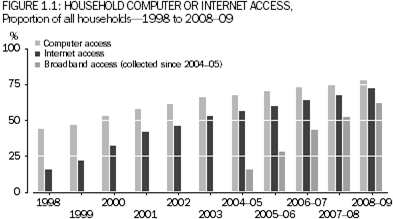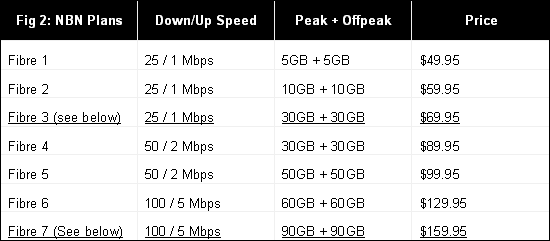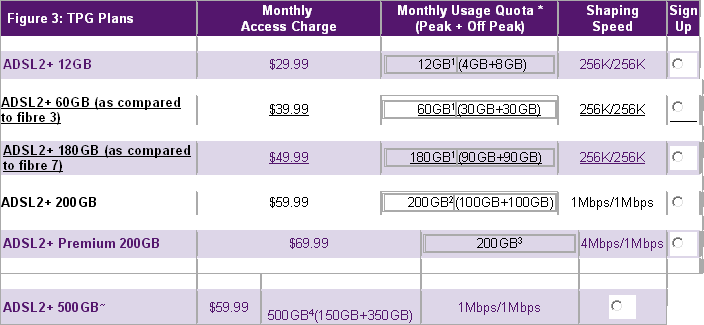There has been a lot of hype about the national broadband network and why Australia needs to spend $43 billion to upgrade every home in Australia to this target. As the statistics below clearly show, the demand for broadband is increasing in the percentage of households, and the creaky infrastructure presently owned by Telstra is the limiting factor in reaching the capacities available in other OECD countries.

There is no doubt that the 100 or 1000 Megabits per second (Mbps) is a massive capacity, and will meet the needs of everyone for the foreseeable future, but then $43bn is a huge sum of money, about $5,400 per household. While for some this is a drop in the ocean, for most people this is a fair chunk of change.
Advertisement
The questions that need to be asked seriously before expenditure of this nature is authorised are:
- What capacity is required by what function.
- Who needs what capacity (functions) currently, in the next 10 years, and for the long term.
- What would the cost of these new capacities be in comparison to what we have now?
- Where are the bottlenecks and can they be upgraded in stages?
Before directly addressing capacity requirements, what is often forgotten is that while computer hardware capacity has accelerated dramatically in the last 10 years, so has software. In particular, as a spin off from the investment in encryption, compression technology has advanced in leaps and bounds.
For example images, music and video no longer require the capacities they used to.
A 10 megapixel photo occupies 40MB as a bitmap image or 750kB as a Jpeg; a CD used to store 40 minutes of music in standard format, but can now store 1,000 mins as Mpeg; and a wide screen feature film used to require a DVD (4.7GB) but can now be stored on a CD (800MB) in AVI format.
Capacity required by function
So here are some of the functions people might require from broadband and their modern day band width requirements:
Advertisement

Minimum requirements for audio conferencing

Minimum requirements for 1-to-1 video conferencing

Minimum requirements for 4-way video conferencing
Other requirements that home users might require (with modern compression technologies) are:
- VOIP (Internet telephone) 56kbs;
- interactive gaming < 1Mbps;
- streaming video (wide screen) < 3 Mbps;
- streaming HD video (1920 x 1080) < 9 Mbps;
- small home-based web business < 1Mbps.
The only unlimited requirement would be downloads. If one wants to download a movie nearly instantly, then this would be the only area where 100-1000Mbps would make a significant difference.
So, for most normal functions, including all home business, medical, etc the requirements are easily covered with a 10Mbps capacity, and 90 per cent of functions are covered by a standard 1.5Mbps capacity.
The final issue with bandwidth is that irrespective of the bandwidth that the user is capable of, often the limitation is on the global network, or the website being accessed. One only needs to try and access Facebook during peak times to experience snail-like speed due to the pressure on Facebook’s server.
Functions required by user, now, in the short term, and in the long term
Referring to the figure 1.1 and starting at the lower end of the demand curve, the 20 per cent who don’t own computers presently, either through aversion to technology or financial circumstances, are unlikely to demand high speed broadband either now or in the short term. However, in the long term the percentage of non-computer owners is likely to diminish.
The percentage of dial up internet users is the fastest shrinking component, and with the advent of cheap broadband, and the inconvenience of sharing a line with the phone, this does not require great genius to predict that this small percentage is likely to reach close to zero in the short term.
The existing broadband users are more difficult to differentiate between those with low use/low speed users and high use/high speed users. Estimates are that some households (i.e. those with teenage children) are the high speed/bandwidth consumers, but that the substantial majority fall below the 2Mbps and 20GB a month consumption.
As to the next decade and beyond, the IT game is changing so rapidly, that the answer to requirements from 2020 and beyond can only be that 100Mbps may well become the new minimum requirement.
Comparison of the pricing of the new capacities compared with what is available today
Given the proposed pricing model for the new NBN (not the introductory offers):

NBN Plans Down/Up Speed Peak + Offpeak Price
The vast majority of consumers would not be considerably better off considering that what they gain in speed they sacrifice in monthly bandwidth compared with existing plans: for example, (TPG available only in the cities)

TPG Plans Monthly
The conclusion would be that where cheap and relatively fast ASDL2+ is available, such as in the higher density cities, there is very little incentive to move to the proposed NBN plans. The take up in small country areas where there are fewer, slower and more expensive internet providers (such as Tasmania) the take up of the NBN plan is likely to be higher. (The quoted figure is 80 per cent at a much reduced introductory price.)
Where are the bottlenecks and can they be upgraded in stages?
There is some confusion as to what constitutes “the network”, and what traffic goes where. The network can simplistically be broken into three distinct areas:
- Major arterial routes between exchanges and the outside world which are presently serviced by microwave, fibre, etc. The limit here places a restriction on the total traffic, and requires bandwidths to be restricted to prevent rush hour freeway type congestions.
- Connection between the exchanges and the junction boxes at the street corners is presently serviced by large multi-pair cables. In the junction box each pair of the multi pair cable is then run separately to each house. The bandwidth is constricted by the sum of the distance from the exchange to the junction box and the junction box to the house.
- Connection between the street corner junction boxes and the home.
The NBN plan is to:
- Upgrade the major arterial routes (estimated cost of $2.4bn). This increases the total combined bandwidth possible at any moment.
- Install fibre from the exchanges to street corner junction boxes (estimated cost of $3.5bn). This removes the length of the copper pair connection from the exchange to the junction box and greatly increases the home capacity. This is obviously better where the distance from the junction box to the house is lower. But gives speeds greater than 12Mbps and as high as 50Mbps.
- Install fibre from the street corner junction boxes to each individual home (estimated cost of $36bn), which removes the final bottle neck in speed and gives the final home speed to 100/1000Mbps.
The alternative plan offered by another party would be to do stages 1 and 2, and to defer stage 3 on a needs basis.
In answer to the question as to whether the NBN plan is required in its entirety, I would have to say that it will be required, but not yet or not even for the next decade.